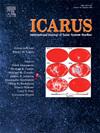Mie theory-based light scattering analysis of entrained grains in Io's Tvashtar plume observed during new horizons' 2007 flyby
IF 2.5
2区 物理与天体物理
Q2 ASTRONOMY & ASTROPHYSICS
引用次数: 0
Abstract
Io, the most volcanically active body in the Solar System, frequently produces large-scale plumes capable of reaching hundreds of kilometers in height. During the 2007 New Horizons (NH) flyby, the Tvashtar Catena region exhibited a ∼ 350 km high “Pele-type” plume whose canopy radiance in scattered sunlight increased unexpectedly by an order of magnitude over 3–4 days. This radiance surge occurred as the solar phase angle between the Sun, Io, and NH rose from ∼40° to 150°, suggesting that observational geometry could play a key role; earlier investigations found that changes in basic volcanic vent parameters, such as stagnation temperature and vent area, did not fully explain this irregular brightness increase (Adeloye et al., 2025).
In this study, we utilize Mie theory to characterize light scattering and integrate multiple lines of analysis to identify the primary factors influencing Tvashtar's plume radiance. We employ Direct Simulation Monte Carlo (DSMC) modeling to simulate SO2 gas dynamics and entrained basaltic grains, assuming a log-normal grain size distribution. Additionally, we examine multiple factors that could potentially contribute to the observed phenomena, including variations in the NH observation geometry, the scattering properties of individual and ensembles of grains, and vent parameters such as mass flow rate and grain mass loading.
Our results indicate that no single factor can fully account for the irregular brightness surge. Instead, a combination of observational geometry effects, the optical scattering behavior of the grains in the plume, and changes in grain mass loading are required to reproduce the observed radiance profile and its changes. Although our methodology assumes continuous, steady-state ejection over tens of minutes and does not explicitly model condensation, sublimation, or episodic grain injection at the vent, the integrated approach presented here offers a novel perspective on plume dynamics at Io. These findings not only enhance the interpretation of the NH Tvashtar observations but also provide a framework for future investigations of Io's volcanic plumes and potential exploration missions.
基于Mie理论的光散射分析,在新地平线号2007年飞掠时观测到木卫一的塔瓦斯塔羽流
木卫一是太阳系中火山活动最活跃的天体,经常产生能够达到数百公里高度的大规模羽流。在2007年新视野号(NH)飞掠的过程中,Tvashtar Catena地区呈现出高达350公里的“pele型”羽流,其散射阳光的冠层辐射在3-4天内意外地增加了一个数量级。当太阳、木卫一和北半球之间的相位角从40°上升到150°时,这种辐射激增发生,这表明观测几何可能起关键作用;早期的研究发现,基本火山口参数的变化,如停滞温度和喷口面积,并不能完全解释这种不规则的亮度增加(Adeloye et al., 2025)。在这项研究中,我们利用Mie理论来表征光散射,并整合多条分析线来确定影响“塔瓦斯塔”羽流辐射的主要因素。我们采用直接模拟蒙特卡罗(DSMC)模型来模拟SO2气体动力学和夹带玄武岩颗粒,假设颗粒尺寸分布为对数正态分布。此外,我们研究了可能导致观测到的现象的多种因素,包括NH观测几何形状的变化,单个和整体颗粒的散射特性,以及排气参数,如质量流量和颗粒质量负荷。我们的结果表明,没有一个单一的因素可以完全解释不规则的亮度激增。相反,需要结合观测几何效应、羽流中颗粒的光学散射行为以及颗粒质量载荷的变化来重现观测到的辐射廓线及其变化。虽然我们的方法假设连续的、稳定的喷射持续数十分钟,并且没有明确地模拟在喷口处的冷凝、升华或偶然的颗粒喷射,但这里提出的综合方法为木卫一的羽流动力学提供了一个新的视角。这些发现不仅加强了对NH Tvashtar观测结果的解释,而且为未来对木卫一火山羽流的调查和潜在的勘探任务提供了一个框架。
本文章由计算机程序翻译,如有差异,请以英文原文为准。
求助全文
约1分钟内获得全文
求助全文
来源期刊

Icarus
地学天文-天文与天体物理
CiteScore
6.30
自引率
18.80%
发文量
356
审稿时长
2-4 weeks
期刊介绍:
Icarus is devoted to the publication of original contributions in the field of Solar System studies. Manuscripts reporting the results of new research - observational, experimental, or theoretical - concerning the astronomy, geology, meteorology, physics, chemistry, biology, and other scientific aspects of our Solar System or extrasolar systems are welcome. The journal generally does not publish papers devoted exclusively to the Sun, the Earth, celestial mechanics, meteoritics, or astrophysics. Icarus does not publish papers that provide "improved" versions of Bode''s law, or other numerical relations, without a sound physical basis. Icarus does not publish meeting announcements or general notices. Reviews, historical papers, and manuscripts describing spacecraft instrumentation may be considered, but only with prior approval of the editor. An entire issue of the journal is occasionally devoted to a single subject, usually arising from a conference on the same topic. The language of publication is English. American or British usage is accepted, but not a mixture of these.
 求助内容:
求助内容: 应助结果提醒方式:
应助结果提醒方式:


